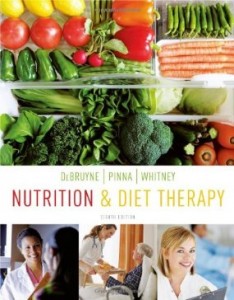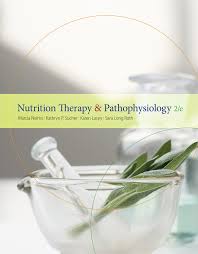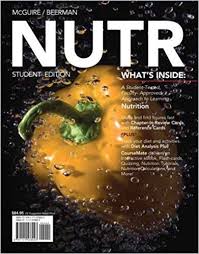Test Bank For Nutrition And Diet Therapy 8th Ed By Whitney
Original price was: $75.00.$35.00Current price is: $35.00.
Test Bank For Nutrition And Diet Therapy 8th Ed By Whitney is one of the most comprehensive and well-rounded nutrition textbooks on the market. It provides students with a solid foundation in the basics of nutrition, including the latest research on the role of nutrition in health and disease.
The book also features a wealth of practical information on how to implement nutritional therapy in clinical practice. In addition, the Test Bank for Nutrition and Diet Therapy 8th Ed By Whitney offers an invaluable resource for instructors, helping them to develop and assess student learning. Overall, this textbook is an essential tool for anyone interested in pursuing a career in nutrition or dietetics.
Digital item No Waiting Time Instant Download
Description
Test Bank For Nutrition And Diet Therapy 8th Ed By Whitney
Chapter 5 – Digestion and Absorption
Answer, K/A, page(s) K = knowledge question; A = application question
True/False
T K 107 1. A nutrient or other substance must pass through the cells of the digestive tract wall before it actually enters the body.
F K 107 2. Digestion is completed in the large intestine.
F K 110-111 3. Segmentation propels or pushes food through the GI tract while peristalsis mixes the food, with a more gradual pushing motion.
T K 111 4. The mouth initiates the liquefying process to reduce the food to a coarse mash suitable for swallowing.
F K 111 5. Of all the organs in the GI tract, the small intestine has the thickest walls and strongest muscles.
T K 113 6. Saliva protects tooth surfaces and the linings of the mouth, esophagus, and stomach from attack by molecules that might be harmful.
F K 113-114 7. Pepsin cannot function in the strong acid of the stomach.
T K 115 8. Drinking plenty of water in conjunction with eating foods high in fiber supplies fluid for the fiber to take up, thus relieving constipation.
F K 117 9. Some partially digested nutrients can be caught in the microvilli, but they cannot be further digested.
F K 117 10. People should not eat certain food combinations at the same meal because the digestive system cannot handle more than one task at a time.
Multiple Choice
c K 107 1. Another name for the digestive tract is the:
a. urinary tract.
b. exocrine system.
c. gastrointestinal system.
d. muscular system.
d K 107 2. The digestive tract begins at the ____ and ends at the ____.
a. stomach; large intestine
b. pharynx; rectum
c. lower esophageal sphincter; rectum
d. mouth; anus
b K 107 3. A bolus is a(n):
a. sphincter muscle separating the stomach from the small intestine.
b. portion of food swallowed at one time.
c. enzyme that hydrolyzes starch.
d. portion of partially digested food expelled by the stomach into the duodenum.
b K 107 4. The _____ is formed in the mouth.
a. bile
b. bolus
c. chyme
d. villus
d K 107 5. The _____ prevents food from entering the lungs.
a. lower esophageal sphincter
b. pharynx
c. ileocecal valve
d. epiglottis
d K 107 6. The stomach empties into the:
a. ileum.
b. cecum.
c. jejunum.
d. duodenum.
a K 107 7. Chyme is:
a. a semiliquid mass of partially digested food.
b. a portion of food swallowed at one time.
c. an enzyme in the stomach needed for the digestion of protein.
d. an esophageal secretion.
a K 107 8. Two organs that secrete digestive juices into the small intestine are the _____ and _____.
a. gallbladder; pancreas
b. pancreas; liver
c. gallbladder; liver
d. duodenum; pancreas
b K 107 9. The movement of chyme from the stomach into the small intestine is regulated by the:
a. pancreas.
b. pyloric sphincter.
c. ileocecal valve.
d. duodenum.
c K 108 10. Immediately before passing into the large intestine, the food mass must pass though the:
a. pyloric sphincter.
b. lower esophageal sphincter.
c. ileocecal valve.
d. bolus.
d K 110-111 11. “Peristalsis” is a term that refers to the:
a. circulation of blood in the blood vessels.
b. absorption of food in the intestines.
c. mixing and moving of food through the lymphatic system.
d. action of the involuntary muscles of the digestive tract.
a K 110-111 12. Involuntary muscle contractions move food through the intestinal tract. The movement that forces the contents back a few inches before pushing it forward again is called:
a. segmentation.
b. rotation.
c. peristalsis.
d. liquefaction.
a K 113 13. Enzymes:
a. facilitate chemical reactions.
b. draw water into the small intestine.
c. are present in all parts of the GI tract.
d. encourage bacterial growth.
c K 113 14. Which specific enzyme breaks down starch in the mouth?
a. carbohydrase
b. lipase
c. salivary amylase
d. gastric protease
c K 113 15. Saliva contains an enzyme that digests:
a. proteins.
b. minerals.
c. starches.
d. vitamins.
c K 113 16. Which of the following is not a component of gastric juice?
a. water
b. enzymes
c. chylomicrons
d. hydrochloric acid
a K 113 17. The normal pH of the stomach is:
a. very acidic.
b. slightly acidic.
c. neutral.
d. slightly alkaline.
e. strongly alkaline.
d K 107, 113 18. Which of the following organs does not contribute juices during digestion?
a. salivary glands
b. small intestine
c. pancreas
d. esophagus
c K 113 19. The function of mucus in the stomach is to:
a. neutralize stomach acid.
b. activate pepsinogen to pepsin.
c. protect stomach cells from gastric juices.
d. emulsify fats.
b K 113 20. The major digestive work in the stomach is the initial breakdown of:
a. starch.
b. proteins.
c. fat.
d. vitamins.
a K 113 21. In addition to hydrochloric acid, the stomach cells also secrete:
a. mucus.
b. bile.
c. amylase.
d. lipoproteins.
c K 114 22. The major digestive enzyme secreted by the stomach is:
a. amylase.
b. lipase.
c. pepsin.
d. disaccharidase.
a K 114 23. The nutrients that are digested in the small intestine are:
a. carbohydrate, fat, and protein.
b. fat, water, and fiber.
c. protein, vitamins, and fiber.
d. water, fiber, and minerals.
c K 109,113-14 24. The digestion of proteins begins in the _____ and ends in the _____.
a. stomach; pancreas
b. pancreas; small intestine
c. stomach; small intestine
d. small intestine; liver
a K 113-114 25. Which of the following organs is the primary source of digestive enzymes?
a. pancreas
b. gallbladder
c. small intestine
d. liver
d K 114 26. After the pancreatic juices have mixed with chyme in the intestine, the resulting mixture is:
a. very acidic.
b. slightly acidic.
c. strongly alkaline.
d. slightly alkaline.
b K 114 27. The liver:
a. reabsorbs water and salts.
b. secretes bile.
c. churns food to chyme.
d. performs enzymatic digestion.
a K 114 28. The main function of bile is to:
a. emulsify fats.
b. stimulate the activity of protein digestive enzymes.
c. neutralize the intestinal contents.
d. decrease the acidity of the contents of the stomach.
a A 114 29. If the gallbladder becomes diseased, the digestion of _____ can become compromised.
a. fat
b. protein
c. carbohydrate
d. fiber
d K 114 30. The gallbladder:
a. reabsorbs water and salts.
b. churns food to chyme.
c. performs enzymatic digestion.
d. stores bile.





Be the first to review “Test Bank For Nutrition And Diet Therapy 8th Ed By Whitney”